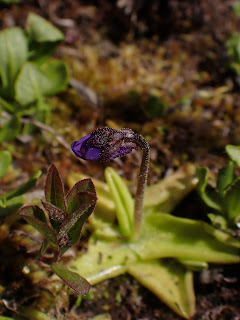I met a new friend this spring, and I’ve been heading up north to visit them every chance I get. We didn’t meet online exactly, but I did use an app to figure out their location. You see, I read about them over the winter, and just had to find out more about their life! They are a little odd – they supplement their diet with insects and make an unusual kind of yogurt – and they may not be hanging out this far south for very much longer.
Being a botany nerd, I call this new friend of mine Pinguicula vulgaris, a plant also known as Common Butterwort.
I first encountered butterwort in a wonderful book called North Shore: A Natural History of Minnesota's Superior Coast, by Chel Anderson and Adelheid Fischer. Although I bought the book at an author talk when it first came out in 2015, I’m still not quite finished. Yet every time I sit down to read, I discover something new! This book was the first place I learned that the leaves of a pitcher plant cradle an entire community of life, which I’ve now written and taught about too many times to count.
“Defying the ravages of waves and ice to this day are such rare prizes as butterworts, whose pinwheels of pale green leaves cling like glistening starfish to the wet faces of the bedrock shore,” Anderson and Fischer wrote. Amazing! Now this was someone I had to meet. “Find butterwort” appeared in bold text on my mental bucket list.
I put down the book and picked up my phone. Using the “Explore” tab in my iNaturalist app, I quickly pulled up a map with little green pins dotting the shore of Lake Superior from Two Harbors up to Grand Portage, all around the Canadian North Shore, and over into Michigan as well. Zooming even farther out (iNaturalist data is global!!!) I discovered even more pins – locations where other naturalists have made observations of this same plant – throughout Washington, Alaska, Canada, Greenland, Iceland, the United Kingdom, and all over Europe. Common Butterwort is circumboreal, and occurs all around the top of the globe. Northern Minnesota and Wisconsin are just beyond the southern edge of this ecoregion.
 |
| iNaturalist map of Common Butterwort observations. inaturalist.org |
On a late May trip to Grand Marais, MN, I poked around on the bedrock trails of Artist’s Point to see what I could find.
 |
| Artist's Point, Grand Marais, MN |
The first rare plants to catch my eye were Bird’s Eye Primrose, a species I’d first admired in Alaska. Nestled into the mosses nearby were the small rosettes of roundly triangular, chartreuse leaves of butterwort. Sweet! I knew it was too early for flowers, but I was excited to see deep purple buds rising on little stalks from the center of many of the rosettes.
I also noticed a smattering of tiny bugs stuck to the leaves. Take that, mosquitoes!
Like pitcher plants, Common Butterwort is carnivorous. Their leaves are covered with little stalks, each tipped with a tiny drop of sticky liquid, not unlike the leaves of sundew, another carnivorous plant. Small insects get stuck on these drops, and their struggles stimulate the leaf to curl in on itself and release digestive enzymes. To prevent the insects from rotting – i.e. getting eaten by bacteria – while they are being digested by the plant, butterwort also releases antibacterial chemicals.
Although the name butterwort comes from the greasy look the sticky glands give to their leaves, the enzymes on their leaves are able to curdle milk. What? A plant who can make cheese? But it makes sense. Rennet, a key component of cheesemaking, is sourced from the stomachs of young cows, sheep, or goats. These carnivorous leaves are essentially exposed stomachs. The Swedes use butterwort leaves to make filmjölk, a breakfast food similar to yogurt.
In order to absorb the nitrogen and phosphorous they need from their insect prey, butterworts must open pores on their leaf surfaces. This puts them in danger of drying out, which is why butterworts grow in cool, humid places, and why they occur only in a few specialized habitats this far south.
Two weeks later, in early June, I returned to Artist’s Point on one of those cool, damp days so typical of Grand Marais. Just as I’d hoped, the buds had opened to reveal lovely purple flowers – similar to violets – with long nectar spurs and hairy white tongues. Only large insects could get past the hairs to reach the nectar, so the bees, butterflies, and moths who might be pollinators are also strong enough to escape death-by-leaf should they accidentally land on one.
As I approached one of the neatest pockets of moss, sedges, primrose, and butterwort in a little bedrock terrarium, I was surprised to find a white square of PVC surrounding the bouquet, and a person looking intently at the plot, notebook in hand. While I didn’t know this person, I knew the type: scientist!
Someday soon I’ll tell you more about why both of these new friends were at Artist’s Point that day!
Emily’s award-winning second book, Natural Connections: Dreaming of an Elfin Skimmer, is available to purchase at www.cablemuseum.org/books and at your local independent bookstore, too.
For more than 50 years, the Cable Natural History Museum has served to connect you to the Northwoods. The Museum is open with our brand-new exhibit: “Anaamaagon: Under the Snow.” Our Fall Calendar will open for registration on August 1! Follow us on Facebook, Instagram, YouTube, and cablemuseum.org to see what we are up to.



.JPG)

















